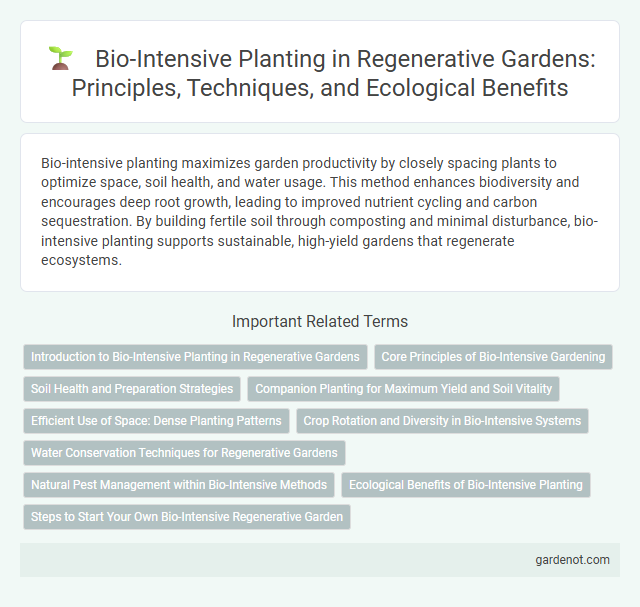Bio-intensive planting maximizes garden productivity by closely spacing plants to optimize space, soil health, and water usage. This method enhances biodiversity and encourages deep root growth, leading to improved nutrient cycling and carbon sequestration. By building fertile soil through composting and minimal disturbance, bio-intensive planting supports sustainable, high-yield gardens that regenerate ecosystems.
Introduction to Bio-Intensive Planting in Regenerative Gardens
Bio-intensive planting in regenerative gardens emphasizes maximizing crop yields while enhancing soil health through deep soil preparation, composting, and close plant spacing. This method promotes biodiversity by integrating a variety of plants that support each other's growth and improve nutrient cycling. Efficient water use and carbon sequestration are key benefits, making bio-intensive planting a sustainable approach to regenerative agriculture.
Core Principles of Bio-Intensive Gardening
Bio-intensive gardening focuses on core principles such as maximizing yields from small spaces, enhancing soil fertility through composting and double-digging, and promoting biodiversity by planting companion crops. This method prioritizes deep soil aeration, close plant spacing, and carbon-rich soil amendments to sustain long-term productivity. Emphasizing seed saving and crop rotation helps maintain soil health and resilience within a regenerative garden system.
Soil Health and Preparation Strategies
Bio-intensive planting emphasizes maximizing soil fertility and structure through deep double digging, organic matter incorporation, and crop rotation to enhance soil microbial activity and nutrient availability. Strategies include applying compost and mulch to maintain moisture and suppress weeds, alongside planting nitrogen-fixing cover crops to naturally replenish soil nitrogen. Prioritizing soil health in regenerative gardens fosters resilient ecosystems, supporting diverse plant growth and sustainable yields.
Companion Planting for Maximum Yield and Soil Vitality
Bio-intensive planting leverages companion planting techniques to enhance crop yield and improve soil vitality by pairing compatible plants that support each other's growth through nutrient exchange and pest management. Strategic combinations such as legumes with heavy feeders increase nitrogen availability, while deep-rooted plants aerate the soil, promoting microbial activity and soil structure. This approach optimizes space and resources, resulting in sustainable, high-yield regenerative gardens.
Efficient Use of Space: Dense Planting Patterns
Bio-intensive planting maximizes efficient use of space through dense planting patterns that increase yield per square foot. By closely spacing compatible crops, this method improves soil health, conserves moisture, and suppresses weeds naturally. The strategic arrangement of plants enhances microclimate benefits, leading to higher productivity and sustainable garden ecosystems.
Crop Rotation and Diversity in Bio-Intensive Systems
Bio-intensive planting emphasizes crop rotation and diversity to enhance soil fertility and pest management in regenerative gardens. Rotating crops such as legumes, leafy greens, and root vegetables prevents nutrient depletion and disrupts pest cycles. Incorporating diverse plant species supports beneficial microbial activity and promotes resilient ecosystem function in bio-intensive systems.
Water Conservation Techniques for Regenerative Gardens
Bio-intensive planting in regenerative gardens maximizes water conservation by promoting deep root systems that enhance soil moisture retention and reduce irrigation needs. Techniques such as mulching, using drought-resistant plant varieties, and implementing micro-catchments significantly decrease water runoff and evaporation. Integrating rainwater harvesting and drip irrigation further optimizes water efficiency, supporting sustainable garden growth.
Natural Pest Management within Bio-Intensive Methods
Bio-intensive planting enhances soil fertility and plant health through deep soil cultivation and companion planting, creating a robust ecosystem that naturally suppresses pests. Natural pest management in bio-intensive gardens relies on attracting beneficial insects like ladybugs and lacewings, which prey on common pests without chemical interventions. This method fosters biodiversity, reduces the need for synthetic pesticides, and supports sustainable, regenerative gardening practices.
Ecological Benefits of Bio-Intensive Planting
Bio-intensive planting maximizes yields by improving soil fertility through composting and deep root cultivation, which promotes aeration and water retention. This method enhances biodiversity by encouraging beneficial insect habitats and companion planting that naturally reduces pests and diseases. Soil carbon sequestration is increased, mitigating climate change by capturing atmospheric CO2 and improving overall ecosystem resilience.
Steps to Start Your Own Bio-Intensive Regenerative Garden
Begin by selecting a small, nutrient-rich planting area and prepare the soil with compost to maximize organic matter content. Use double-digging techniques to aerate and loosen the soil, improving root penetration and water retention for bio-intensive planting. Plant densely spaced, diverse crops following companion planting principles to enhance soil fertility and biodiversity in your regenerative garden.
Bio-intensive planting Infographic

 gardenot.com
gardenot.com